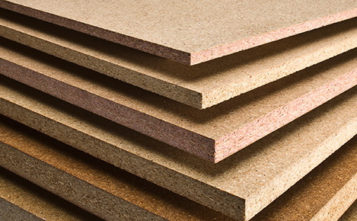The recovery in U.S. housing construction, an expanding global furniture industry, and strong growth in housing construction in rapidly developing countries in Eastern Europe and Russia will lead to a boom in particleboard production by 2017.
According to Australian industry analyst BIS Shrapnel’s latest Particleboard in the Pacific Rim and Europe 2013-2017 report, Europe – which is still struggling to return to growth following the global financial and economic crisis – will be the main beneficiary of the boom, with exports set to more than double during the forecast period as production expands in Belarus, Bulgaria, Hungary, Latvia, and Russia.
But the report warns that price growth may be limited as consumption is forecast to significantly lag behind production, unless non-producing regions increase their demand.
Particleboard is used mainly for furniture and cabinet manufacturing in most regions. In 2012, particleboard used for furniture and cabinet making ranged from a low of 18 per cent to 20 per cent of total particleboard consumption in Australasia and South Africa, to a high of 80 per cent to 90 per cent in China, India, Malaysia, Vietnam and South American countries.
Western Europe (excluding Russia and Turkey) remains the dominant particleboard producing region, accounting for 38.9 per cent of the world’s production in 2012, or 28.7 million cubic metres. This will increase slightly by 2017. Based on forecasts, Europe, including countries such as Belarus, Bulgaria, Hungary and Latvia, will produce 34.8 million cubic metres, accounting for 39.3 per cent of global production.
The greater European region, including Russia and Turkey, is by far the largest producing region with 53.4 per cent of the world’s production in 2012. This will increase to 53.9 per cent by 2017.
“The economic crisis hasn’t ceased for Western Europe, and in 2012 it was the only region with a GDP close to zero,” said report author and senior manager, Bernie Neufeld. “However, if there is one industry that has remained stable in the greater European region, it’s the particleboard production industry – and times are only expected to get better over the forecast period.
“Net exports from Europe (excluding Russia and Turkey) are projected to increase substantially over the forecast period, from 2.3 million cubic metres in 2012 to 5.6 million cubic metres in 2017.
“With prices also expected to increase over the forecast period it’s a good time to be in the particleboard industry in Europe, and you can’t say that about too many industries in the region, sadly.”
Economic Prospects, and Global Production and Consumption Forecasts
The downturn in housing construction in the United States reached the bottom of the cycle in 2009. Housing construction began to recover in 2010, and is well on the way to much stronger growth over the next five years.
“This recovery will drive economic growth not only locally but in many of its key trading partners around the world,” said Neufeld. “It will also drive renewed demand for furniture, and ultimately the demand for particleboard. Housing construction in other key regions such as South America and Asia will also drive demand.”
Production of particleboard by major producing countries is projected to increase from 73.6 million cubic metres in 2012 to 88.6 million cubic metres in 2017, based on current expansion plans and estimated capacity utilisation rates.
But production at current plans is forecast to outnumber consumption globally, leading to a potential surplus. Consumption in the major producing countries is projected to increase from 72.2 million cubic metres in 2012 to 84.8 million cubic metres in 2017.
“Given the projected increase in production to 88.6 million cubic metres over the same period, consumption in non-producing countries and regions such as the Middle East, Africa, and other South American countries will need to be in the order of 3.8 million cubic metres by the end of the forecast period for a surplus to be avoided,” said Neufeld. “Therefore, price increases will be constrained somewhat by the expected surplus in supply.”
Particleboard prices declined in 2009 immediately following the global financial and economic crisis, and increases have been modest over the past five years. Prices in 2012 across all regions -- which are estimates -- averaged US$296 per cubic metre.
Prices are projected to increase by five per cent in 2014 and six per cent in 2015, as global economies strengthen. Slower growth is projected for 2016 and 2017 in response to the next cyclical downturn.
Europe
The greater European region including Russia and Turkey is by far the largest producing region, and production is forecast to increase from 53.8 million cubic metres in 2012 to 56.7 million cubic metres in 2017.
North Asia
North Asia was the second largest producing region in 2012, with 19.9 per cent of the production, or 14.6 million cubic metres. The region’s share of production is projected to decline to 17.8 per cent by 2017, although production will actually increase to 15.8 million cubic metres. Production in Japan and Korea is projected to remain flat, and all of the increase in production will be in China.
South Asia
South Asia was the fourth-largest producing region in 2012, when it produced seven million cubic metres of particleboard with a 9.5 per cent share of global production. This is projected to increase to 7.8 million cubic metres in 2017, but the region’s share of production is projected to decline to 8.7 per cent in 2017.
South America
Significant new addition to capacity will increase production from five million cubic metres in 2012 to 7.3 million cubic metres in 2017, resulting in an 8.2 per cent share of global production. Strong growth in the economies of this region, especially Brazil, will be a significant driver of production.
Australasia and South Africa
Australasia has around a 1.2 per cent share of global production and South Africa has less than one per cent. This is not expected to change significantly over the forecast period.







Leave a Reply